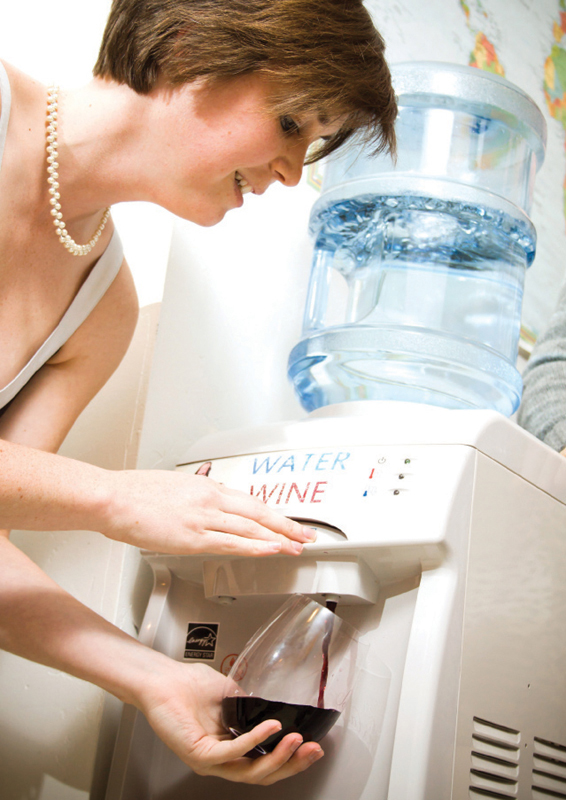
WATER to WINE COOLER
Our miraculous illusion converts water into flowing red wine.
![]() TIME: A WEEKEND
TIME: A WEEKEND ![]() COST: $$$
COST: $$$

Brian J. Matis
Our longhaired friend Greg was planning a Jesus-themed birthday party, and people joked about a cool possible prop: a machine that would seemingly convert water to wine. “Hey!” we thought. “We can do that!”
We obtained a ceramic-crock water dispenser, sprinkler valves, aquarium pumps, and assorted PVC fittings, and proceeded to make a glorious mess nearly every time we tried to create the illusion, because we would inadvertently start a siphon that we couldn’t stop.
At the last minute before the party, we made it work, but it wasn’t pretty. The wine container sat on a shelf behind the dispenser while the pumping system sat on the floor — all of it draped with sheets, making it obvious that some shenanigans were taking place. Partygoers were still impressed, and the effect was certainly delivered. But we couldn’t resist the urge to remake the Water-to-Wine Cooler as the awesome contraption it deserves to be.
We brainstormed with block diagrams until we found a simple design we liked. Then we shopped for a water cooler. We knew we needed to electrically capture the mechanical action of the dispense button, covertly. We eventually found a GE water cooler that was perfect. It had hot and cold taps, so we could dispense wine out of the cold side, and for those in the know, room-temperature water from the hot side.
Block diagram of W2W electronics and plumbing systems
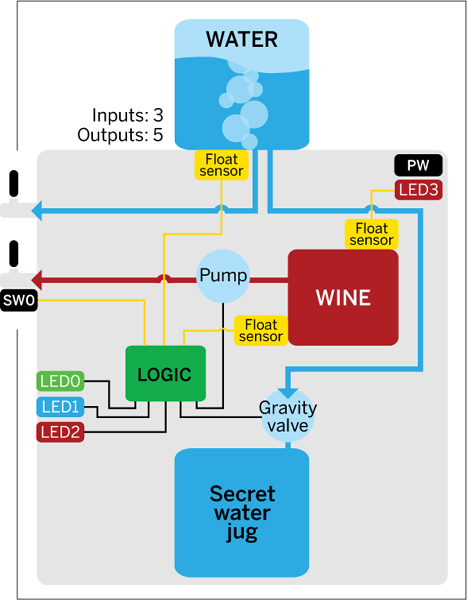
A. First we gutted the cooler, removing the water reservoir, heater, LED board, and this refrigerant compressor. (Dispose of properly.)
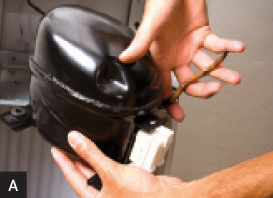
B. This mini lever switch, modified with a 4" extension, engages the trick system when the cooler’s cold water button is pressed.

C. The hidden wine reservoir is a polypropylene box fitted with a right-angle “empty” float sensor and bulkhead outlet, plus a straight “full” float sensor in the lid.

D. The wine pump sits in a plastic container of its own, surrounded with bubble wrap to quiet it down.
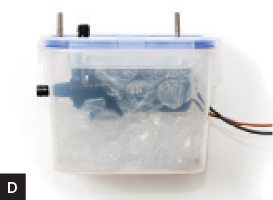
E. Inputs and outputs are wired to the microcontroller board using Molex snap connectors for easy disassembly. The code implements a simple state machine: Idle, Dispense, Out of Water, Out of Wine, and Out of Water and Wine.

F. The wine reservoir’s refill tube runs to a bulkhead fitting on the back panel, for party in-flight refueling.
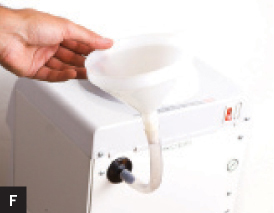
For the gurgling effect, we tried pumping air into the water bottle without letting water out. But we quickly saw that the excess pressure would have no place to go, unless we put a vent in the top of the bottle — and if we did, water would back-flow through the air pump and start a siphon. Again.
Our solution was to hide an identical water bottle below, for the top one to drain into. This lets the water level decrease over the course of the party, which is more realistic. When the water gets low, you just swap bottles and you’re back in business. We added a fill port for the wine and LED indicators to notify us if something needs attention.
The finished Water-to-Wine Cooler (W2W) is indistinguishable from a normal water cooler, and we can stand at a distance and chuckle as our unsuspecting friends go from shock, to bewilderment, to amusement.
W2W Design
In the unmodified GE cooler, the inverted jug on top empties into a reservoir with two pipes coming out, one to the refrigeration unit and the other to the heating element. We rerouted one pipe directly to the hot water tap, and the other to a gravity valve that controls flow to the second jug hidden in the bottom of the cooler.
We added a plastic reservoir to hold the wine, and installed electronics and plumbing so that a press of the cold water button simultaneously drains water into the lower jug and pumps wine out the cold water tap.
Control comes from an Olimex ATmega AVR microcontroller development board with 4 relay outputs. The inputs to the board are a mini lever switch triggered by the cold water tap, a “water is empty” float switch, and a “wine is empty” float switch. On the output side, 2 relays control the water drain valve solenoid and the pump that dispenses the wine. The board also controls 3 LEDs that flash to show that the software is working and to indicate empty water and wine reservoirs.
Layout of secret W2W components inside the cooler (rear view)
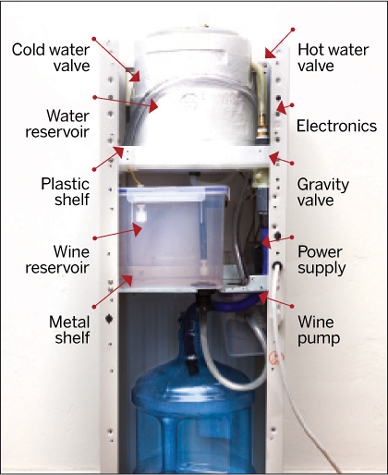
Finally, a wine-full float sensor connects directly to an LED that shines through a small hole in back, bypassing the microcontroller, to let you know when to stop pouring refill wine. W2W has a lot going on inside, but after you remove the compressor and heater from inside the cooler body, and if you use 3-gallon jugs instead of 5-gallon, it all fits.
The result is a miraculous illusion where water glugs down from the bottle to emerge mysteriously from the tap as wine. We debuted our new W2W machine at BarBot, a cocktail robotics event in San Francisco, to many laughs. To throw your own water-to-wine party, follow our build instructions and download the W2W code at makezine.com/34. ![]()
Pierre Michael is an electrical engineer at iRobot, where he works on robots that save lives. Robert Kaye is a founder of the MetaBrainz Foundation, which uses acoustic fingerprinting to identify and tag large collections of music. Both work and live in San Luis Obispo, Calif.

JOIN THE ROBOT Uprising
While the word robot was only invented in 1920, the idea of humans creating something that moves and acts on its own, as if alive, is ancient. Today, robots serve us as workers, protect us as soldiers, and amuse us as toys. And tomorrow? No one really knows, but one thing is certain: For makers in the here and now, the world of robots is wild, wonderful, and ready to be hacked. Here’s our peek at what some bot makers are working on.
